Latin America’s Largest University Hosts International Conference on “The Prototype Genocide of Modern Times” in Partnership with Zoryan Institute and Governments of the State of Sao Paulo and the Republic of Armenia.
Scholars from Argentina, Armenia, Brazil, Canada, Switzerland, Turkey and the United States participated in an international conference, the first of its kind in Brazil, on ―The Prototype Genocide of Modern Times,‖ held at the University of Sao Paulo (USP), Brazil, April 22-24, in commemoration of the 95th anniversary of the Armenian Genocide.
The conference was co-organized by the University of Sao Paulo Laboratory for the Study of Ethnicity Racism and Discrimination, the State Government of Sao Paulo Secretary of Institutional Affairs, the Consulate General in Sao Paulo representing the Government of Armenia, and the Zoryan Institute.
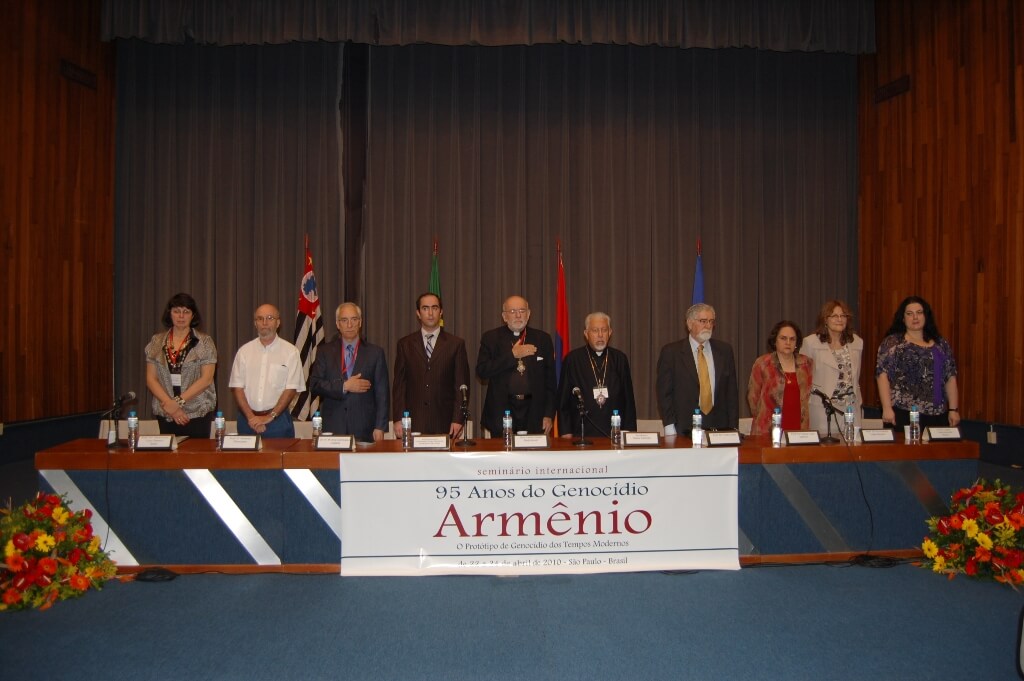
Opening panel left to right: M. Tucci Carneiro, M. Florenzano, K. Sarkissian, A. Harutyunyan, Dom V. Boghossian,
Archbishop D. Karibian, C. Lafer, M. Marcilio, E. Negrão, L. Yeghiazaryan.
The conference was opened by Prof. Dra. Maria Luiza Tucci Carneiro, Associate Professor at the Department of History, USP, and Coordinator of the Laboratory for the Study of Ethnicity Racism and Discrimination. She welcomed everyone and described the reasons for the university’s partnership in this conference.
Prof. Dr. Celso Lafer, former Brazilian foreign and commerce minister, Professor of Philosophy of Law at USP and President of the Research Foundation of the State of Sao Paulo, spoke strongly in affirming the Armenian Genocide. He was followed by Prof. Dr. Dalmo de Abreu Dallari, Emeritus, Faculty of Law of USP, and a jurist with the Permanent Peoples’ Tribunal. He noted that the Verdict of the Tribunal’s hearing in Paris in 1984 on the Armenian Genocide was key in the UN Sub-commission of Human Rights Report of 1985, affirming that the World War I Armenian experience at the hands of the Ottoman Turks was genocide.

Celso Lafer

Dr. Dalmo de Abreu Dallari,
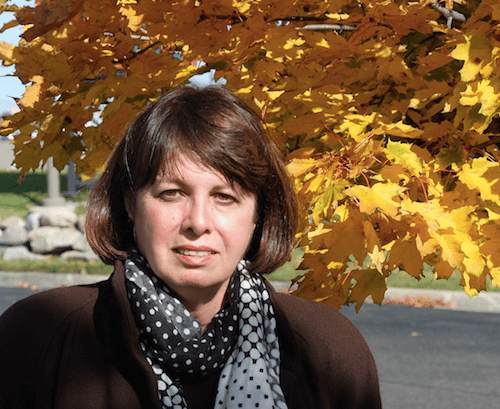
Prof. Dra. Maria Luiza Tucci Carneiro
K.M. Greg Sarkissian, President of the Zoryan Institute, in his opening presentation of the academic portion of the conference, explained the rationale for the theme, “the prototype of modern genocide.” He described the phenomenon, whereby a government turns against an identifiable ethnic minority among its own citizens with the intention of destroying them, as a
perceived solution to its political problems. This marked a change from the mass slaughter of populations that occurred many times throughout history, associated with war, imperialism and conquest. The Armenian Genocide is now widely understood to be the “prototype” of modern genocide, as labelled by Prof. Robert Melson, who first coined the term.
Sarkissian explained the meaning of April 24, which the beginning of deportation and mass killings of the Armenian, Assyrian and Greek population of the Ottoman Empire. He added, “The year 1915 was the beginning of the Ottoman genocidal policy of ethnic cleansing and massacres, which continues in Turkey today because of its official state policy of denial.” He noted that Prof. Roger W. Smith first pointed out some years ago, and it is now recognized by scholars, that denial is the last stage of genocide, since it continues to victimize the survivors and their descendants. Noting that Brazil was among the first countries to vote for the Universal Declaration of Human Rights and sign the UN Genocide Convention in 1948, Sarkissian called upon Brazil to be among those countries who refuse to be complicit in the ongoing crime of genocide denial by officially recognizing it.
Prof. Steven L. Jacobs of the University of Alabama gave a comprehensive explanation about Raphael Lemkin, the man who conceptualized and coined the term “genocide.” He pointed out Lemkin’s obsession with the fact that there were no laws to punish the mass killing of a whole people, such as the Armenians, by their own government, Ottoman Turkey, even though there were laws for punishing the killing of a single person. The 1921 trial in Berlin for the assassination of Talat Pasha, one of the architects of the Armenian Genocide, by Soghomon C. Lafer Tehlirian and his acquittal was a major influence on Lemkin and his determination to secure international support outlawing the crime of genocide through the United Nations. Lemkin considered the Armenian case so important that it is the only case in all of his papers where a full-length manuscript has been written independently and accompanied by a shorter manuscript. In that study he noted,”A strong parallel may be drawn between the extermination of the Armenians by the Turks and the extermination of the Jews by the Germans.”
Dr. Sévane Garibian, Senior Lecturer in Philosophy of Law at the University of Neuchâtel, Switzerland, spoke on “The Armenian Genocide and the Development of the Modern Concept of Crimes against Humanity.” She described the declaration of the Allied Powers on May 24, 1915, which said, in essence, “In view of these new crimes of Turkey against humanity and civilization, the Allied governments announce publicly … that they will hold personally responsible … all the members of the Ottoman government and those of their agents who are implicated in such massacres,” and explained how this was a major event in bringing the concept of “crimes against humanity” into modern international law.
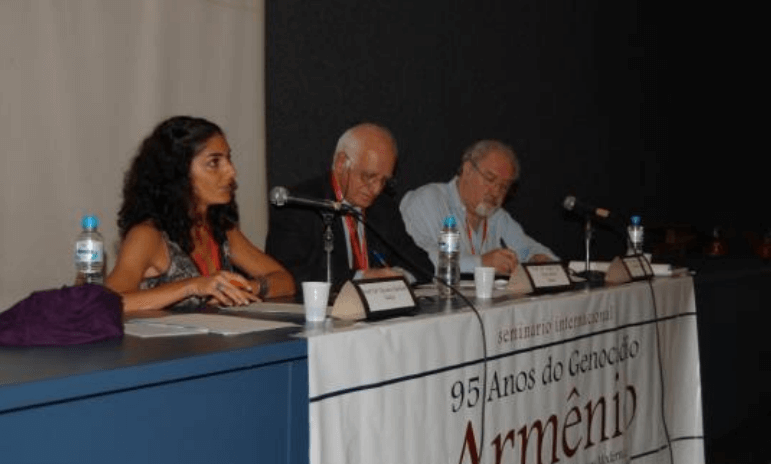
Left to right: S. Garibian, J. Meihy, S. Jacobs.
Mr. Ragip Zarakolu, renowned human rights activist and publisher in Turkey, spoke about Modern Turkey and the Armenian Genocide.‖ He made insightful comments about the nature and motives of denial of the Armenian Genocide by the Turkish State. He drew parallels with the State’s problematic treatment of other subjects in the political and social life of the country, specifically in relation to minorities and their rights. For example, currently about 1,000 midlevel Kurdish politicians are jailed, preventing them from running in the next election. Zarakolu emphasized that the AKP, Turkey’s current ruling party, has made some progress in adopting certain European standards into Turkey’s constitution, under the pretext of democratization. However, the gag order imposed on the Armenian Genocide issue, coupled with the replacement of military hegemony in the country’s institutions by a new hegemony of a police state, has raised fear among Kurds, Alevis and non-Muslim minorities of the outbreak of mass violence against them, just like the Armenians 95 years ago.
Prof. Dra. Maria Luiza Tucci Carneiro, of the USP, spoke about “Brazil in Front of the Armenian Genocide, the Holocaust and the UN Resolution.” She analyzed Brazil’s political position— government, press and Brazilian diplomats—since the Armenian Genocide until the integration of the crime of genocide in International Law. Through diplomatic documents and articles published by important Brazilian newspapers, she related the multiple discourses about the Armenian Genocide as prototype of the modern genocide, from 1915 to 1948. She referred to historical archives that documented Armenian refugees fleeing the Genocide and coming to Brazil. She explained how politicians during the debate at the UN on the Genocide Convention felt that issue did not concern them, stating, “Brazilian people are homogeneous, made up of heterogeneous races. Therefore, the problem of genocide does not concern us directly. It is a crime the common Brazilian man cannot figure out, but it horrifies him anyway.” However, in 1956, Brazilian law accepted genocide as a crime, adopting the same definition ratified by the UN Convention.
Prof. Emeritus Robert F. Melson of Purdue University discussed “The Armenian Genocide as Precursor and Prototype of Modern Genocide,” taking a comparative approach. He put forward the position that the Armenian Genocide was not only the first total genocide of the 20th century, but that it also served as the prototype for genocides that came after. In particular, the Armenian Genocide approximates the Holocaust, but at the same time, its territorial and national aspects, which distinguish it from the Holocaust, make it an archetype for ethnic and national genocide. In both the Armenian Genocide and the Holocaust, a deliberate attempt was made by the government of the day todestroy an ethno-religious community of ancient provenance. When comparing the two cases, a pattern becomes apparent. This pattern shows some differences, however, and it is those differences that link the Armenian Genocide not only to the Holocaust but also to later instances of that crime.
Prof. Vahakn N. Dadrian, Director of Genocide Research at the Zoryan Institute, analyzed “The Armenian Genocide as a Dual Problem of National and International Law.” He described first the elements of the Armenian Genocide within Turkish national law after the end of WWI. These include the charge of crimes against humanity by the Allied Powers, the post-war debates in the Ottoman Chamber of Deputies and Senate about what had happened to the Armenians, and the Military Tribunal and Courts Martial, which prosecuted the perpetrators of “crimes against the Armenians” Within international law, he pointed out that principles arising out the Armenian case are found in the Nuremberg charter and in the UN Genocide Convention, and in comparison with the Eichmann case, the principle of state succession. Thus, Turkey is responsible for acts committed by the Ottoman State.
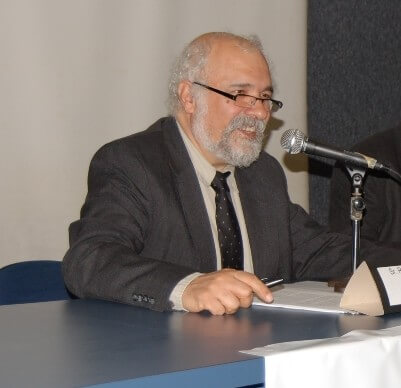
R. Zarakolu

Left to right: R. Melson, L. Yeghizaryan

V.N. Dadrian
Prof. Dr. Marcio Seligmann-Silva, Lecturer of Literary Theory at the University of Campinas in Sao Paulo and researcher at the National Council of Technological and Scientific Development, spoke on “The Armenian Genocide and the Question of Evil Memory in the XX Century.” He dealt with the question of the necessity of bearing witness after genocide as a way to give meaning to the event and to allow for the progression from victim to citizen with rights, including the right to sue in court those responsible for the genocide. Bearing witness is often confronted with denial. Nevertheless, it is a process that encompasses individual, collective and national trauma and allows the victim to work through the envisaging of justice, truth and the reconstruction of the person and of post-genocide societies. The Armenian Genocide occupies a key position in the history of genocides and of denial. As an example of extreme genocide denial, it argues for the necessity of bearing witness.
Prof. Emeritus Roger W. Smith of the College of William and Mary, and also Chairman of the Academic Board of Directors of the Zoryan Institute, spoke on “Remembrance and Denial.” Without remembrance of past examples of genocide, there would be no sense of urgency in the present, no perceived need to prevent future atrocities. We would cut ourselves off from the knowledge of the causes and sequences of genocide, knowledge that might help prevent other peoples from being subjected to this crime against humanity. Denial of genocide has become the universal strategy of perpetrators. Those who initiate or otherwise participate in genocide typically deny that the events took place, that they bear any responsibility for the destruction, that the term “genocide” is applicable to what occurred. Denial, unchecked, turns politically
imposed death into a “non-event.” The Armenian Genocide, in fact, illuminates with special clarity the dangers inherent in the political manipulation of truth through distortion, denial, intimidation, and economic blackmail. No other regime has gone to such extreme lengths to deny that a massive genocide took place as Turkey. That democratic governments (the United States, Great Britain, and Israel) have supported Turkey in that effort, raises significant questions
about governmental accountability and the role of citizenship in a world in which truth increasingly comes in two forms “official” and “alleged.”
Prof. Khatchik Der Ghougassian teaches international relations at the University of San Andrés in Buenos Aires and is a Visiting Adjunct Professor at the American University of Armenia. He analyzed the complexities of “The Armenian Genocide and international power relations.” In the 19th century, the European Powers utilized the struggle for the rights of the non-Muslim minorities as one of their pretexts for involvement in the Ottoman Empire. After the start of World War I, the Allied Powers made the first international attempt at humanitarian intervention by warning the Young Turk leaders that they would be called to account for their wholesale massacre of Turkey’s Armenian population. After the post-WWI peace negotiations, Armenia dropped from the international agenda until 1965, 50 years after the Genocide, when Armenians around the world began to revive the world’s attention and conscience on that injustice. The Armenian Genocide has come increasingly on the world stage as an issue in the United Nations, as a subject of official recognition b national and international governments and official bodies, and even as an issue for Turkey’s accession to the European Union. He discussed the place of the Armenian Genocide in Armenia’s foreign policy and suggested how it could be employed more effectively.
Prof. Herbert Hirsch, Professor of Government and Public Affairs at Virginia Commonwealth University, explored “The Lessons of the Armenian Genocide for the Prevention of Genocide.” Within the last ten years, at least four major international and national prescriptions have appeared outlining the mechanisms necessary to prevent genocide. Hirsch analyzed their strengths, weaknesses, confirming that action lags behind academic forums. This is because the overriding principles in international relations are state sovereignty and national interest. The study of the genocides of the 20th century has suggested to analysts certain models for the prevention of genocide. These include humanitarian intervention, protection of civilians, peacemaking, and punishment of the perpetrators. This has led to calls for creating an early warning system which would alert the public and exert pressure on nations or groups to stop atrocities, and the creation of a UN Rapid Reaction force. Each of these has its shortcomings that limit freedom of action, to monitor, follow prescription, and establish rules of engagement while doing no harm, and including the ability to build. The adoption of the Responsibility to Protect has been a step in the right direction, but this has not been effective because of the lack of political will. Hirsch explored the sources of this lack of political will.
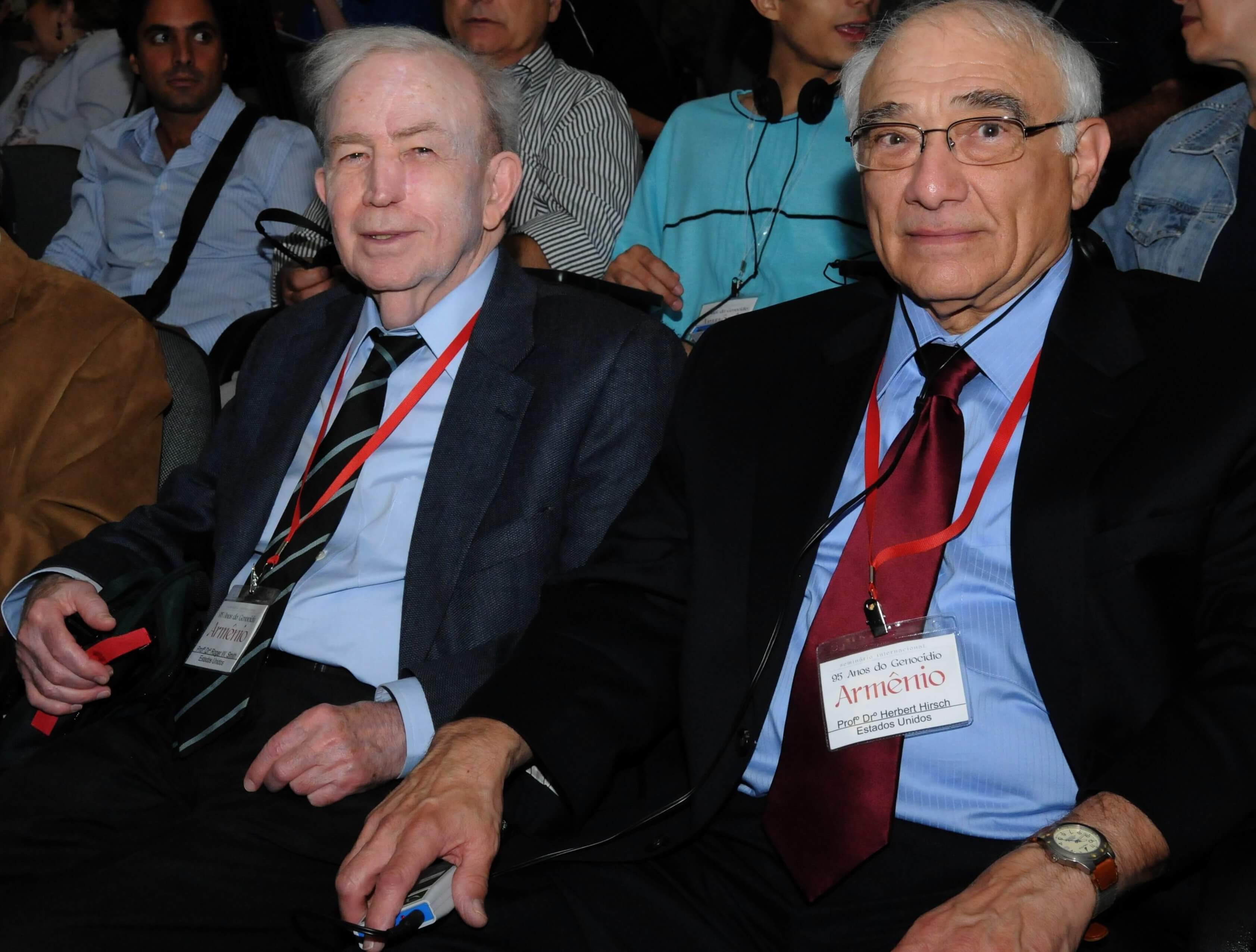
Left to right: R.W. Smith, H. Hirsch
Prof. Dr. Anita Novinsky, Historian and Lecturer of the Department of History and President of the Laboratory of Studies on Intolerance, USP, spoke on “Education for Life.” She described the profound questions philosophers and theoreticians have wrestled with in modern times regarding how man can commit such violence against fellow humans. In the words of Theodor Adorno, the fight against war and aggression will be in vain if we do not change our educational systems. We can find the reasons of the genocides in the 20th century in the resurrection of aggressive nationalisms. She described how perpetrators of genocide are formed during their childhood years, and proposed the need for an educational system that teaches the value and the sanctity of human life.
The Zoryan Institute is the parent organization of the International Institute for Genocide and Human Rights Studies, which runs an annual, accredited university program on the subject and is co-publisher of Genocide Studies and Prevention: An International Journal in partnership with the International Association of Genocide Scholars and the University of Toronto Press. It is the first non-profit, international center devoted to the research and documentation of contemporary issues with a focus on Genocide, Diaspora and Armenia. For more information please contact the Zoryan Institute by email zoryan@zoryaninstitute.org or telephone (416) 250-9807.










